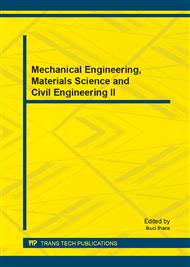[1]
Huang N E, The empirical mode decomposition and the hilbert spectrum for nonlinear and non-stationary time series analysis, Proc. R. Soc. Lond. A. 454(1998) 903-995.
DOI: 10.1098/rspa.1998.0193
Google Scholar
[2]
Cheng J S, Yu D J, Tang J S, Local rub-impact fault diagnosis of the rotor systems based on EMD, Mechanism and Machine Theory. 44(2009) 784-791.
DOI: 10.1016/j.mechmachtheory.2008.04.006
Google Scholar
[3]
Yaguo Lei, Zhengjia He, Yanyang Zi, Application of the EEMD method to rotor fault diagnosis of rotating machinery, Mechanical System and Signal Processing. 23(2009) 1327-1338.
DOI: 10.1016/j.ymssp.2008.11.005
Google Scholar
[4]
Junsheng Cheng, Dejie Yu, Jiashi Tang, Application of frequency family separation method based upon EMD and local Hilbert energy spectrum method to gear fault diagnosis, Mechanism Machine Theory. 43(2008) 712-723.
DOI: 10.1016/j.mechmachtheory.2007.05.007
Google Scholar
[5]
Zhipeng Feng, Ming Liang, Fulei Chu, Recent advances in time–frequency analysis methods for machinery fault diagnosis: A review with application examples, Mechanical Systems and Signal Processing. 38(2013) 165-205.
DOI: 10.1016/j.ymssp.2013.01.017
Google Scholar
[6]
Shu ZH P, Yang ZH CH, A better method for effectively suppressing end effect of empirical mode decomposition, Journal of Northwestern Polytechnical University. 24(2006) 639-643.
Google Scholar
[7]
Tong Xu, Jian Wu, Zhen-Sen Wu etal, Long-Term Sunspot Number Prediction based on EMD Analysis and AR Model, Chinese Journal of Astronomy and Astrophysics. 8(2008) 337-342.
DOI: 10.1088/1009-9271/8/3/10
Google Scholar
[8]
Liu H T, Zhang M, Cheng J X, Dealing with the end issue of EMD based on orthogonal polynomial fitting algorithm, Computer engineering and application. 40(2004) 84-86.
Google Scholar
[9]
G. F. Bin, J.J. Gao, X.J. Li, etal, Early fault diagnosis of rotating machinery based on wavelet packets—Empirical mode decomposition feature extraction and neural network, Mechanical System and Signal Processing. 27(2012) 696-711.
DOI: 10.1016/j.ymssp.2011.08.002
Google Scholar
[10]
Cheng J S, Yu D J, Yang Y, Application of support vector regression machines to the recessing of end effects of Hilbert-Huang transform, Mechanical Systems and Signal Processing. 21(2007) 2750-2760.
DOI: 10.1016/j.ymssp.2005.09.005
Google Scholar
[11]
Shi P M, Ding X J, Li G, etal, An improved method of EMD and its application in rotating machinery fault diagnosis, Journal of Vibration and Shock. 32(2013) 185-190.
Google Scholar


